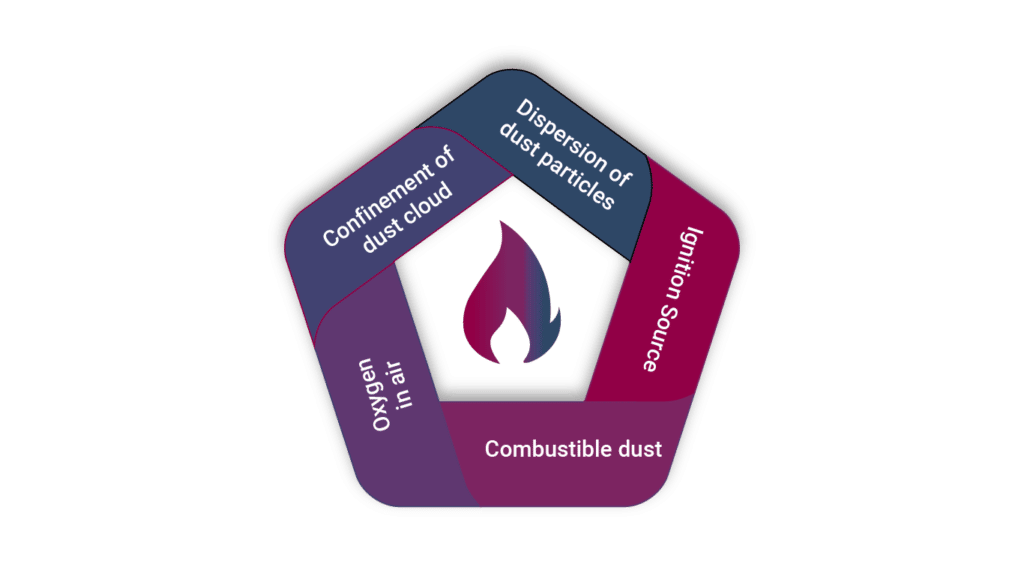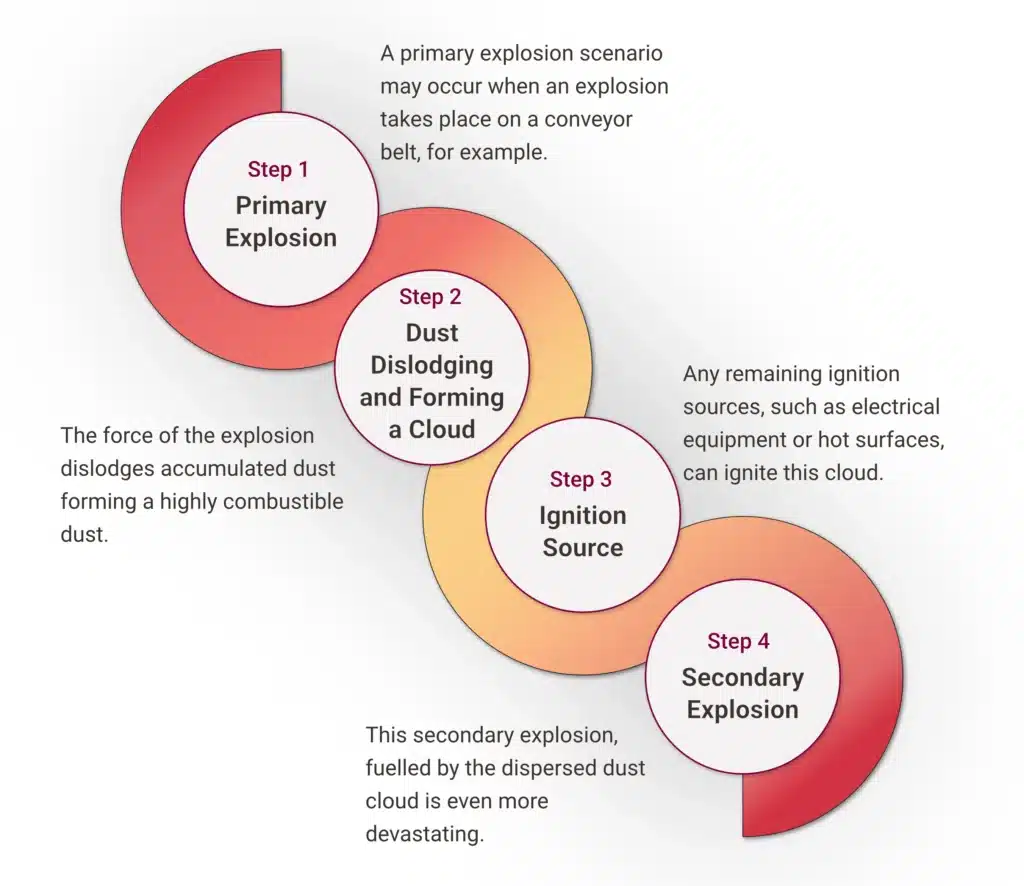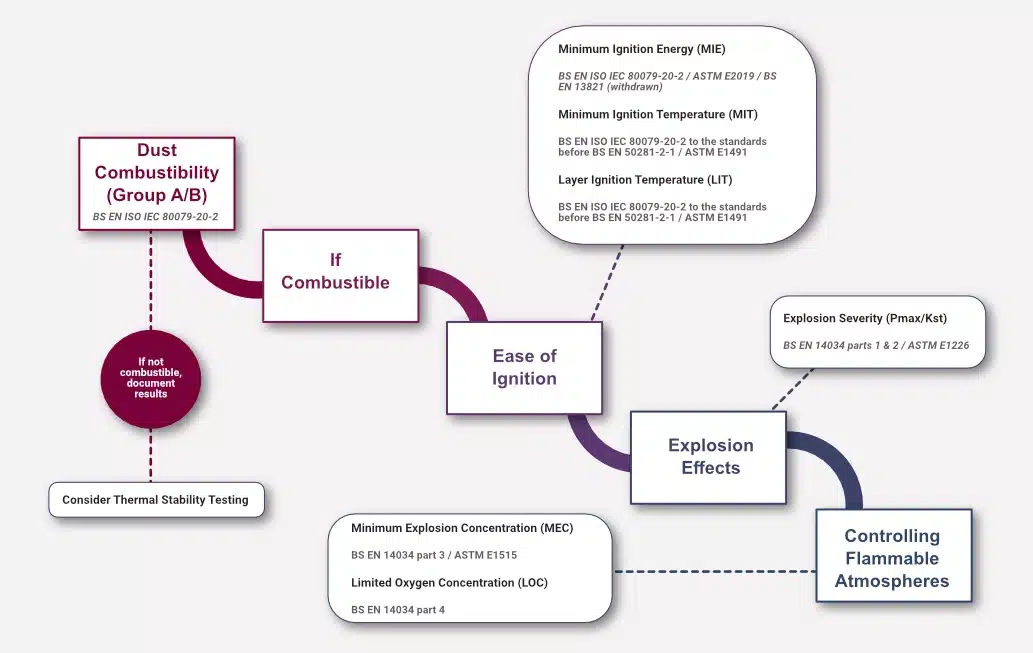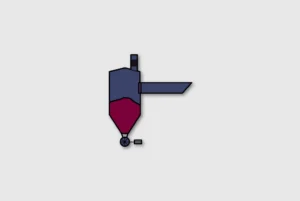Combustible dust poses a significant risk to workers and facilities in various industrial settings.
When dealing with combustible dust, it’s fundamental to conduct accurate laboratory testing to determine combustibility or explosibility. Testing aids in identifying hazards associated with combustible dust, while a thorough risk assessment will aid in identifying and mitigating the risks associated with combustible dust at your facility.
At Sigma-HSE, we specialise in providing expert consulting and testing services. Our team of technical consultants and engineers have extensive experience in assisting various industries in managing combustible dust risks.
What is combustible dust and its associated hazards?
Combustible dust refers to fine particles that can ignite and explode when suspended in the air in certain concentrations. These dust particles are generated from numerous materials such as metals, wood and plastics.
Understanding the properties and risks associated with combustible dust is crucial for maintaining a safe working environment.
Varied industries, including agriculture, manufacturing, and food processing, are susceptible to combustible dust hazards. Common materials such as flour, sugar, coal, and metal powders can generate combustible dust. The accumulation of dust in confined spaces or on surfaces can create an explosive atmosphere, leading to catastrophic consequences.
The primary hazards of combustible dust include fire and explosions. An electrical spark or other ignition sources can trigger a dust explosion, resulting in property damage, injuries, and even fatalities.
What are the 5 elements of a combustible dust explosion?
For a combustible dust explosion to occur, several critical factors must align. While the Dust Explosion Pentagon shares similarities with the conventional fire triangle—comprising of fuel, oxidant, and an ignition source— a combustible dust hazard can extend beyond these elements to include confinement and dispersion.
When all five elements of the Dust Explosion Pentagon are present simultaneously, there is a high risk of a combustible dust explosion occurring. Understanding and managing these elements are crucial for preventing and mitigating the hazards associated with combustible dust in the workplace.

Fuel: Combustible dust serves as the fuel for explosions. It can be in the form of solid particles from various materials, such as wood, metal, or agricultural products. Unlike conventional fires, where the fuel is typically in liquid or gas form, combustible dust particles must first be dispersed in the air to create an explosive atmosphere.
Oxidant: An oxidant, usually oxygen in the air, is necessary to support combustion. When combustible dust particles are suspended in the air, they mix with oxygen, creating the potential for rapid combustion and explosion.
Ignition Source: An ignition source is required to initiate the combustion reaction. This can be anything that provides sufficient energy to ignite the combustible dust particles, such as sparks, flames, hot surfaces, or electrical arcs.
Confinement: Confinement refers to containing or restricting combustible dusts within a defined space. In confined spaces, such as equipment enclosures or ductwork, the accumulation of combustible dust and heat can create a volatile environment. Without proper ventilation or containment measures, the accumulated energy can reach a critical point, resulting in a catastrophic explosion.
Dispersion: Dispersion plays a crucial role in the severity of combustible dust explosions. When dust particles are dispersed in the air, the surface area available for combustion increases significantly. This leads to more rapid and violent combustion reactions than when dust particles are confined or compacted.
What are secondary dust explosions and their risks?
When an initial dust explosion creates a shockwave that disturbs settled dust, leading to subsequent explosions. Fuelled by the dispersed dust cloud, the increased surface area of the dispersed dust allows for rapid combustion, resulting in a more extensive and devastating explosion.
While the initial explosion will cause damage, it is often the secondary explosion that is most devastating.

To mitigate the risks of secondary explosions, it is essential to implement comprehensive combustible dust management practices, including proper housekeeping, equipment design for dust control, hazardous area classification, training for personnel, and the use of explosion protection measures such as deflagration vents, suppression systems, and isolation devices.
Standards for Combustible Dust Hazards
There are numerous standards that are integral to managing and mitigating combustible dust hazards across industries. These standards provide comprehensive guidelines and best practices for preventing fires, explosions, and other safety risks associated with combustible dust.
Explosibility of Dusts
Many individuals often inquire about the need for a risk assessment to determine if their dust is explosive. The answer is usually yes. The reason lies in the potential explosibility of materials used in various processes. Without accurate testing, it’s impossible to ascertain whether a material is explosible.
Samples of the material must be tested in accredited laboratories capable of determining their explosibility. Relying solely on historical data or the absence of previous incidents is insufficient, as conditions may have changed over time or may differ from those in historical records.
Several factors influence the explosibility of materials, including particle size, humidity, and initial temperature. Particle size plays a crucial role, as finer particles have a greater propensity to suspend in the air, increasing the risk of dust explosions. Additionally, environmental conditions such as humidity and temperature can affect the combustibility of materials.
Literature data may not accurately reflect the conditions under which materials are used or stored, making testing essential for ensuring safety.
Dust Combustibility Testing (Go/No-Go | Group A/B)
The dust combustibility test is a critical step in determining whether a material has the potential to explode. This screening process is vital for assessing the explosibility of materials, especially those with high explosive potential.
This test determines whether a cloud of dust dispersed in the air is capable of propagating deflagration, which could lead to a flash fire or explosion. It is a purely qualitative test that categorises a dust or powder into one of two groups:
Combustible – Flammable or explosive
Non-Combustible – Non-flammable or explosive
At Sigma-HSE, we employ specific testing methods to assess explosibility effectively. Testing is conducted using a 20-liter spherical vessel, providing an ideal environment for assessing the potential for deflagration. In cases where sample quantity is limited, a 1-liter cylindrical vessel (Hartmann Bomb) may be used to conduct the necessary screening tests.
It’s essential to recognise that not all materials will exhibit explosibility in dust form. Some materials, such as plastic dust and certain oxides like titanium dioxide or aluminium oxide, may not form explosible dust clouds but can still pose combustion hazards.
For example, while some plastic dust may not explode when suspended in the air, it can melt under certain conditions. Similarly, oxide materials may not form dust clouds but can still ignite and burn when exposed to heat.
Further Testing of Combustible/Explosible Dusts
Even if a material is tested non-explosible through a dust combustibility screening test, it’s crucial to continue with combustibility testing. Combustibility screening tests assess the material’s propensity to burn, providing valuable insights into its fire hazards and safety considerations.

If the material is indeed explosible, it’s imperative to conduct further testing to determine the ease of ignition. This involves identifying the minimum energy and temperature required to ignite the material.
This knowledge is essential in determining necessary safety measures, such as equipment bonding or grounding, or adjusting operational temperatures to mitigate risks posed by potential ignition sources prevalent in industrial settings. Determining the explosibility and ease of ignition of a material involves several crucial parameters:
Ease of Ignition
- Minimum Ignition Energy (MIE) – BS EN ISO IEC 80079-20-2
- Minimum Ignition Temperature, Cloud – BS EN ISO IEC 80079-20-2
- Minimum Ignition Temperature, Layer – BS EN ISO IEC 80079-20-2
- Self-Heating/Thermal Instability – UN Test N.4, Class 4.
Once the ease of ignition is understood, attention must also be given to the potential effects of an explosion. Understanding the severity and consequences of an explosion is vital.
This includes determining the maximum energy release, pressure exertion, burning velocity, and rate of reaction of the material. Such insights are crucial for deciding whether protective or preventive measures against explosion events are warranted for equipment and facilities.
Key parameters to consider include the following explosion severity effects:
- Maximum Explosion Pressure (Pmax) – BS EN 14034 parts 1 & 2
- Maximum Rate of Pressure Rise (dP/dtmax) – BS EN 14034 parts 1 & 2
- Dust Constant Value (KSt) – BS EN 14034 parts 1 & 2
Identifying the minimum amount of material required for ignition and managing oxygen levels are fundamental safety considerations. Understanding the minimum explosible concentration and controlling oxygen levels can enhance safety by ensuring that combustion processes are adequately supported or suppressed.
For instance, reducing oxygen levels below the threshold required for combustion can effectively mitigate risks associated with flammable atmospheres. Additionally, controlling flammable concentrations plays a vital role in safety protocols. This involves:
Controlling Flammable Atmospheres
- Minimum Explosible Concentration (MEC) – BS EN 14034 part 3
- Limiting Oxygen Concentration (LOC) – BS EN 14034 part 4
DSEAR: Identifying and Mitigating Dust Hazards
The Dangerous Substances and Explosive Atmospheres Regulations is a comprehensive assessment that systematically evaluates potential fire, deflagration, and explosion hazards associated with dust (and other dangerous substances) in a process or facility. The primary objective is to recommend measures for effectively managing these hazards and ensuring a safe operating environment.
This analysis identifies safe operating ranges and assesses existing safeguards to mitigate fire, deflagration, and explosion events. Additionally, DSEAR recommends further safeguards as necessary, and is accompanied by a detailed plan for implementation.
Whether existing processes and facilities or new processes, a DSEAR review is required as part of project protocols. DSEAR assessments must be periodically reviewed and updated every two to five years to uphold safety standards.
A DSEAR must be conducted by individuals with proven expertise in the hazards associated with handling and processing combustible particulate solids to ensure a thorough and accurate assessment of potential risks and necessary safeguards.
Combustible Dust Hazards: Preventive Measures and Hazard Control Strategies
To effectively recognise combustible dust hazards, it’s essential to understand the signs and be aware of preventive measures and hazard control strategies. These measures include various strategies to reduce the likelihood of combustible dust incidents occurring in industrial environments.
Implementing rigorous housekeeping practices, conducting regular equipment inspections, and employing explosion protection measures, such as explosion venting and suppression systems. Controlling ignition sources, such as sparks from friction or electrical equipment, is also significant for hazard control.
By prioritising these preventive measures and hazard control strategies, businesses can significantly reduce the likelihood of combustible dust incidents and create safer working environments.



